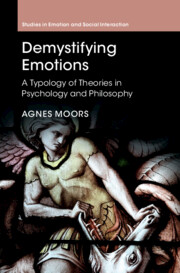Book contents
- Demystifying Emotions
- Studies in Emotion and Social Interaction
- Demystifying Emotions
- Copyright page
- Contents
- Figures
- Tables
- Boxes
- Preface
- Acknowledgment
- Abbreviations
- Part I Introduction
- Part II Emotion Theories One by One
- Chapter 3 General Precursors
- Chapter 4 Evolutionary Theories
- Chapter 5 Network Theories
- Chapter 6 Stimulus Evaluation Theories
- Chapter 7 Response Evaluation Theories
- Chapter 8 Psychological Constructionist Theories
- Chapter 9 Social Theories
- Part III Conclusion
- References
- Index
- Titles Published in the Second Series (continued from page ii)
Chapter 6 - Stimulus Evaluation Theories
from Part II - Emotion Theories One by One
Published online by Cambridge University Press: 11 August 2022
- Demystifying Emotions
- Studies in Emotion and Social Interaction
- Demystifying Emotions
- Copyright page
- Contents
- Figures
- Tables
- Boxes
- Preface
- Acknowledgment
- Abbreviations
- Part I Introduction
- Part II Emotion Theories One by One
- Chapter 3 General Precursors
- Chapter 4 Evolutionary Theories
- Chapter 5 Network Theories
- Chapter 6 Stimulus Evaluation Theories
- Chapter 7 Response Evaluation Theories
- Chapter 8 Psychological Constructionist Theories
- Chapter 9 Social Theories
- Part III Conclusion
- References
- Index
- Titles Published in the Second Series (continued from page ii)
Summary
This chapter discusses stimulus evaluation theories (SETs), which foreground a process of stimulus evaluation (or appraisal). A first brand, called evaluation-first SETs, include appraisal theories in psychology and (quasi-)judgmental and perceptual theories in philosophy. Theories in this brand differ in the role they confer to stimulus evaluation (constituent-only, causal-only, constituent-causal), the granularity of the output of this process (molar, molecular, molar-molecular), and the system required to produce it (in terms of representational format and Attitude, operations, and operating conditions or automaticity). The transition from stimulus evaluation to the other components is accounted for by evaluation-response links that are innate—in the biological version—or learned—in the non-biological version. The latter version splits again in a summary and elemental sub-version. A second brand, called embodied SETs, postulate that stimulus evaluation acquires its heat after bodily responses set in, or they assume an indivisible evaluation-response connection. SETs outperform the previous theories in their capacity to account for the (world-directed) Intentionality of emotions. Most of them can also account for ontogenetic and phylogenetic continuity (except judgmental theories), phenomenality, bodily aspect, heat, control precedence, and irrationality. Molar SETs deliver discrete emotions, purely molecular SETs do not. Empirical research that tests SETs is discussed.
Keywords
- Type
- Chapter
- Information
- Demystifying EmotionsA Typology of Theories in Psychology and Philosophy, pp. 164 - 208Publisher: Cambridge University PressPrint publication year: 2022



